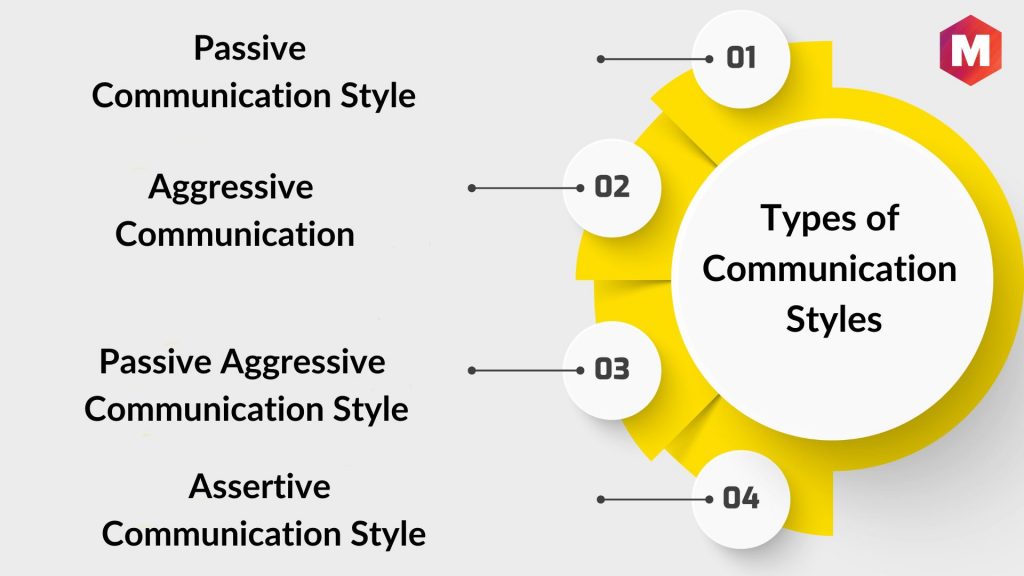
Understanding the Various Styles of Communication

Communication styles are the unique ways in which individuals express themselves Understanding and improving your communication style can enhance relationships and lead to success This article explores the four main communication styles - passive, aggressive, passive-aggressive, and assertive - and their importance in personal and professional settings
The way in which individuals express themselves is known as their communication style. It is common to observe individuals responding in a similar manner to how they were spoken to, which is essentially their communication style. During conversations, the style of communication often holds more significance than the actual words spoken.
What are Communication Styles?
Effective communication is a crucial aspect of any business, and being able to adapt to different communication styles is a key factor in achieving success. In this article, we will explore the four main communication styles and their defining characteristics. So let's dive in and learn more about how to communicate effectively in a variety of contexts.Understanding communication styles is crucial for creating a positive atmosphere both in the workplace and in the community. By learning different styles, we can tailor our language and approach to effectively communicate with a diverse range of people and maintain harmonious conversations. Additionally, this skill can help develop strong leadership qualities.
Importance of Communication Styles
Effective communication is a crucial aspect of personal growth and cultivating lasting relationships. Your communication style plays a pivotal role in this process. Given the diverse backgrounds, cultural differences, and varied life experiences of individuals, it's essential to develop effective communication techniques to navigate different conversations and socialize well.
Diverse patterns and habits in daily life can lead to a breakdown in communication skills for individuals. It is crucial to acquire effective communication skills as they are directly linked to achieving success in various aspects of life. In addition, interacting and socializing with individuals from different backgrounds can expand one's knowledge and broaden their perspective.
Why Managers Should Know different Communication Styles?
in their communication, providing clear expectations and feedback. On the other hand, employees who are Amiables prefer a manager who is approachable and supportive, valuing personal relationships and a positive work environment. Analyticals appreciate a manager who is detail-oriented and logical, providing thorough explanations and data-driven decisions. Finally, Expressives enjoy a manager who is enthusiastic and creative, valuing innovation and open communication. Understanding and adapting to these various social styles can greatly improve a manager’s effectiveness and the overall success of the team.
Rewritten: Amiable employees appreciate having a manager who demonstrates trust in their abilities, reliability, and honesty.
Managers who possess knowledge and are transparent in sharing information tend to attract and retain analytical employees. It is crucial for managers to understand the diverse styles and behavioral tendencies of their employees in order to effectively interact with them.
When managers are versatile and know the needs of many different communication styles well, they can solve the tasks and issues related to –
Conflict
Performance reviews
Goal-setting
The Relation Between Communication Styles and Connections
Knowing different communication styles, one can feasibly socialize with others and build connections by conversing about relatable things and events.
Developing an understanding of communication styles is vital for establishing meaningful relationships, which are a crucial aspect of life. The benefits of cultivating such connections include promoting positive mental and physical health by emanating positive energy.
Good communication, manners, and connections aids in building a successful career.
Efficacious communication styles and long-lasting bonds help in ensuring a familiar and healthy environment.
Being in a relationship has been shown to reduce the likelihood of experiencing depression and anxiety disorders. Moving on to the next topic, it's important to understand the four different communication styles.
Types of Communication Styles
Throughout their lives, individuals acquire various behavioral and non-behavioral traits that often become ingrained or hard to modify. However, it is important for individuals to learn diverse methods of effectively communicating with others and expanding their perspectives and conversational abilities.
Following is the description of four types of communication styles which people must learn:
1. Passive Communication Style
Individuals with a passive communication style struggle to articulate their beliefs and feelings, often neglecting to assert their own needs and rights. This lack of effective communication can result in confusion and tension, causing feelings of annoyance and dissatisfaction.
Passive communicators often exhibit physical cues such as avoiding eye contact, slouching, and a reluctance to speak up for themselves. Despite these traits, they can be trusted confidants who offer compassion and empathy when it comes to personal issues or secrets.
2. Aggressive Communication
Individuals who use aggressive communication styles tend to manipulate others by forcefully expressing their opinions and advocating for their own needs, often at the expense of those around them. Aggressive communicators are typically characterized as rude, abusive, and lacking empathy. Their dominating approach to conversations often results in an inability to actively listen to the concerns of others.
Aggressive communication is often characterized by frequent interruptions, intense glaring, excessive condemnation, and a loud demeanor. Despite these negative traits, individuals who possess these qualities may have the potential to become successful leaders, as their forceful personalities can inspire others to follow them.
3. Passive Aggressive Communication Style
Passive Aggressive communication is a behavior where individuals express their dissatisfaction or anger indirectly, rather than directly addressing the issue. Such individuals often feel trapped, confused, and may experience guilt for their actions.
Passive aggressive communicators often struggle to express their feelings of resentment and may resort to muttering or using excessive sarcasm. They also tend to display facial expressions that are incongruent with their true emotions or intended message.
4. Assertive Communication Style
Assertive communication involves expressing one's own thoughts, feelings, and needs in a clear and respectful manner, while also respecting the thoughts, feelings, and needs of others. It is a communication style that promotes mutual understanding and cooperation, rather than conflict or domination.
Assertive communicators prioritize their time and emotional well-being while also showing respect for the concerns and rights of others. They exhibit clear and confident speech, a relaxed body posture, strong eye contact, emotional control, a calm tone of voice, and a willingness to assert their own rights. Additionally, they often use "I" statements to express ownership and can politely decline the requests of others.
Developing empathy and a compassionate nature, while also maintaining a level of maturity that allows for personal growth, are essential qualities for anyone looking to provide support to others. Additionally, adopting an assertive communication style can help maintain an unbiased perspective and control the balance of emotions and work.
How to Improve Communication Style
To enhance communication in the workplace, it is important to have a clear understanding of your own communication style, including any tendencies towards a submissive approach. This self-awareness can help you recognize how your communication impacts those around you. Additionally, it is crucial to develop strong listening skills and be mindful of your nonverbal cues, such as body language, facial expressions, and gestures. Clear verbal communication is also essential, including attention to vocabulary, grammar, and pronunciation.
To effectively communicate, it's crucial to know how to utilize your skills in a way that ensures your message resonates with your intended audience. Understanding how others perceive you can help you make necessary adjustments when communicating. For instance, if someone doesn't comprehend something, they may need to hear it explained differently by another person.
Communication skills are essential in achieving efficient and timely completion of tasks as it eliminates the need for repetitive explanations. Whether it's for impressing others or accomplishing a task, possessing communication skills is a must-have.
The Link Between Communication Style and Success
Effective communication is a crucial skill for any employee to possess, yet mastering it can be a challenge. Studies show that a mere 25% of employees consider themselves competent in communication, with a mere 2% rating themselves as exceptional. Nevertheless, communication skills are vital for career success, enabling individuals to secure job opportunities, establish connections, resolve conflicts, and more.
Here is a video byon Types of Communication Styles.
Conclusion
Effective communication styles are crucial for personal growth, as they enhance communication abilities, foster positive social interactions, boost self-esteem, and demonstrate empathy towards others' feelings and concerns.
The assertive communication style is widely regarded as the most effective, but it's important to acknowledge the value of the other three styles as well.
In order to foster meaningful discussions and a diversity of opinions, it's crucial for workplaces and communities to embrace a range of communication styles. A dominant style can stifle creativity and lead to a homogenous group of individuals with identical viewpoints.
It would stop the process of learning and knowledge building.
Thus, one should respect individuals of any communication style and be compassionate towards their problems.
Are you aware of your communication style? What style of communication do you expect from your manager? Share your thoughts with us in the comment section below.
NEXT
Ladder Of Abstraction
PREV
Communication Techniques
START
What is Communication












